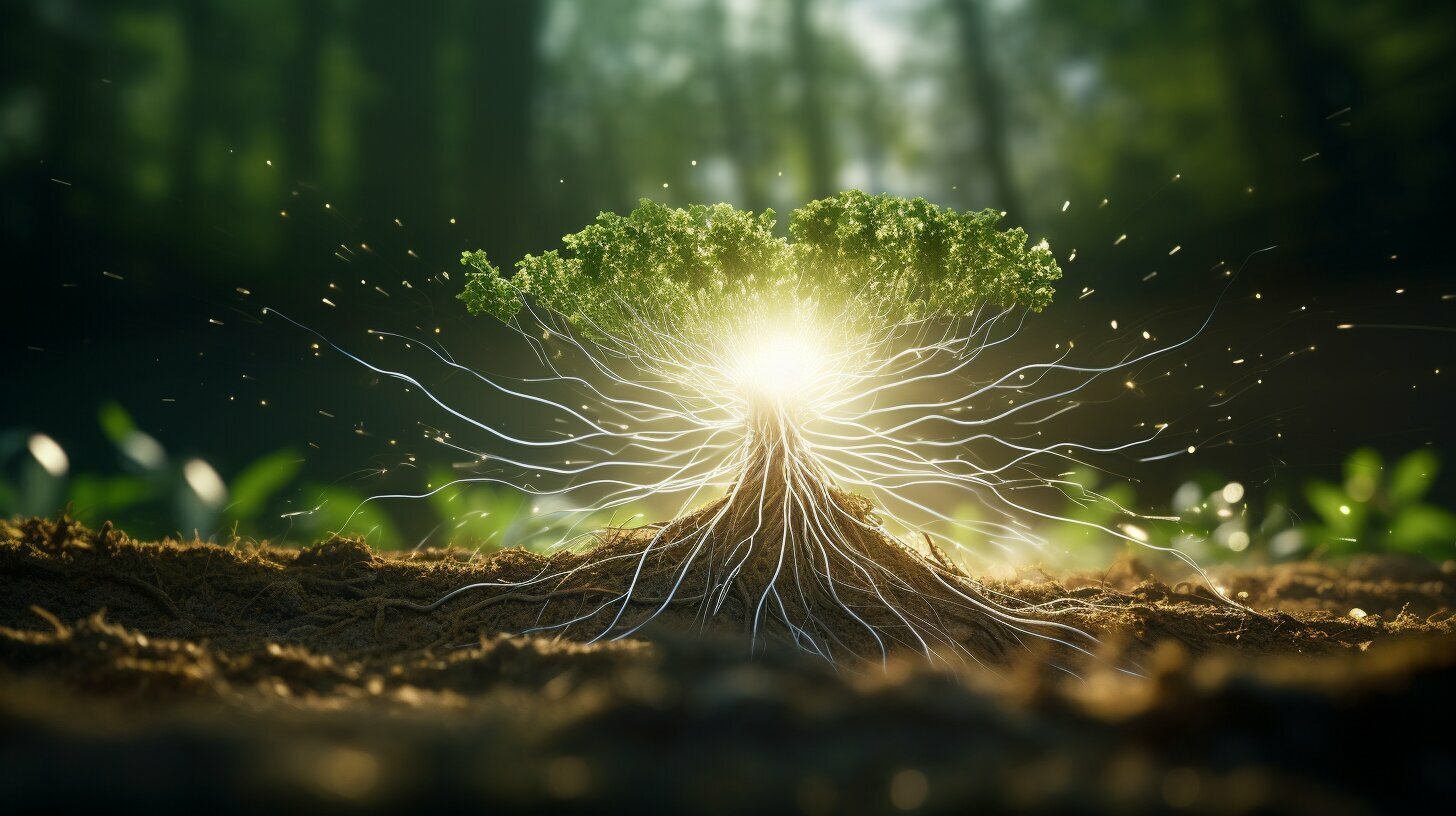Have you ever wondered How Plants Make Oxygen and the air around us is filled with oxygen? The answer lies in the miraculous process of photosynthesis, by which plants generate the life-sustaining gas we breathe.
Plants are not merely decorative, but rather, vital to the survival of all living beings on Earth. They play a crucial role in oxygen production and contribute to the very air we breathe.
Key Takeaways:
- Plants generate oxygen through photosynthesis
- Plants play a crucial role in sustaining life on Earth by producing oxygen
- Understanding how plants generate oxygen is essential in appreciating their contribution to our ecosystem
- Photosynthesis is the intricate mechanism by which plants convert sunlight, water, and carbon dioxide into oxygen
- The rate of oxygen production in plants can be influenced by various factors such as light, temperature, and carbon dioxide availability
The Process of Oxygen Production in Plants
Have you ever wondered how plants produce the oxygen we breathe? It all comes down to the intricate process of photosynthesis, which occurs in the leaves of plants.
The process of oxygen production in plants begins with the absorption of sunlight through chlorophyll, a pigment found in plant cells. This energy is then used to convert water molecules and carbon dioxide into glucose and oxygen through a series of chemical reactions.
But it’s not just photosynthesis that contributes to oxygen production in plants. Plant respiration also plays a crucial role in generating this essential gas. During respiration, plants take in oxygen and release carbon dioxide, which is then used by other plant cells for photosynthesis.
The balance between photosynthesis and respiration is critical for maintaining oxygen levels in the atmosphere. Without plants, we wouldn’t have enough oxygen to sustain life on Earth.
The Process of Oxygen Production in Plants
Let’s take a closer look at the steps involved in the process of oxygen production in plants:
| Step | Description |
|---|---|
| 1 | Chlorophyll pigments absorb sunlight in the plant’s leaves. |
| 2 | The absorbed energy is used to split water molecules into oxygen and hydrogen. |
| 3 | The oxygen is then released into the atmosphere through tiny pores in the leaves called stomata. |
| 4 | The remaining hydrogen is combined with carbon dioxide to produce glucose, a form of sugar that provides energy for the plant. |
| 5 | During plant respiration, oxygen is taken in and carbon dioxide is released to be used in photosynthesis once again. |
As you can see, oxygen production in plants is a complex process that relies on a delicate balance of chemical reactions and cellular functions. But it’s this remarkable mechanism that allows plants to play an indispensable role in sustaining life on our planet.
The Role of Plants in Oxygen Production
Plants play a vital role in generating the oxygen we breathe. Through photosynthesis, plants release oxygen into the atmosphere, making it available for human and animal respiration. Photosynthesis is the process by which plants convert sunlight into chemical energy, enabling them to produce oxygen as a byproduct.
During photosynthesis, plants absorb carbon dioxide and water from the atmosphere, using energy from sunlight to convert them into glucose and oxygen. Oxygen is generated through the breakdown of water molecules, and it is then released into the atmosphere through tiny pores on the surface of plant leaves, called stomata.
Plants are highly efficient oxygen generators, releasing vast quantities of oxygen into the atmosphere. Research shows that terrestrial plants release approximately 220 billion tons of oxygen each year, while oceanic phytoplankton account for around 70% of the oxygen in the Earth’s atmosphere.
It is important to note that not all plants generate oxygen at the same rate. The amount of oxygen generated by different plant species can vary significantly, depending on factors such as environmental conditions, light intensity, and carbon dioxide availability.
Therefore, it is crucial to conserve and care for natural plant ecosystems to maintain important oxygen levels. By preserving plant species and protecting natural habitats, we can ensure the continued generation of oxygen, sustaining life on Earth for generations to come.
The Mechanism of Oxygen Production in Plants
Plants are remarkable organisms that generate oxygen, a byproduct of photosynthesis. This intricate process involves various cellular mechanisms and organelles within the plant.
Photosynthesis is the primary process by which plants produce oxygen. It occurs in the chloroplasts, which are specialized organelles found in plant cells. Within the chloroplasts, there are several structures that play a crucial role in oxygen production, including the thylakoid membrane and the stroma.
The thylakoid membrane is responsible for the first stage of photosynthesis, where light energy is converted into chemical energy. The pigments within the thylakoid membrane absorb light, which energizes the electrons within the membrane. Electrons then move through a series of reactions, producing a molecule called ATP.
The stroma is where the second stage of photosynthesis occurs. In this stage, carbon dioxide is converted into glucose, a sugar molecule that provides energy for the plant’s growth and development. Oxygen is produced as a byproduct of this process, which is then released into the atmosphere.
Factors Affecting Oxygen Production in Plants
The efficiency of oxygen production in plants is influenced by several factors. One of the most significant factors is the availability of light. Plants require sufficient light to carry out photosynthesis, and a lack of light can limit their ability to produce oxygen.
Temperature is another essential factor that can impact oxygen production in plants. Generally, warmer temperatures increase the rate of photosynthesis, leading to higher oxygen production. However, excessively high temperatures can damage the enzymes involved in photosynthesis and reduce oxygen production.
Carbon dioxide availability is also critical to oxygen production in plants. Without sufficient carbon dioxide, plants cannot carry out photosynthesis effectively, which can limit their ability to produce oxygen.
To maximize oxygen production, it is essential to provide plants with the proper care and environmental conditions. Ensure that plants have access to adequate light, temperature, and carbon dioxide levels, as well as sufficient water and nutrients to support vigorous growth.
Photosynthesis and Oxygen Generation
Photosynthesis is the process by which plants convert sunlight, water, and carbon dioxide into glucose (sugar), which serves as food for the plant. As a byproduct of this process, oxygen is released into the atmosphere. This is the oxygen that we breathe.
Plants use specialized structures called chloroplasts to carry out photosynthesis. Within these chloroplasts, pigments called chlorophyll absorb light energy from the sun, which is then used to power the chemical reactions that convert carbon dioxide and water into glucose and oxygen.
The amount of oxygen released by plants through photosynthesis can vary depending on various factors, including the intensity of sunlight, availability of carbon dioxide, and the temperature. So, it’s essential to keep plants healthy and well-cared-for to maximize their oxygen production.
Overall, photosynthesis is a critical process that enables plants to generate the oxygen we need to survive. Without plants, the atmosphere would quickly become depleted of oxygen, making it impossible for humans and other animals to breathe.
Factors Affecting Oxygen Production in Plants
While plants are capable of producing oxygen through photosynthesis, the amount of oxygen generated can vary based on several factors.
One of the main factors that can affect oxygen generation in plants is the availability of light. Without sufficient light, plants may not be able to harness enough energy to generate oxygen efficiently. Temperature can also play a role in oxygen production, as plants may not be able to function optimally in extreme heat or cold.
Furthermore, the level of carbon dioxide present in the environment can also impact oxygen production in plants. Plants rely on carbon dioxide to carry out photosynthesis, and if there is a shortage of carbon dioxide, their ability to generate oxygen may be compromised.
Other factors that can influence oxygen production in plants include soil quality, water availability, and the health of the plant itself. By providing plants with optimal growing conditions, you can help to maximize their oxygen production.
In conclusion, several factors can affect oxygen generation in plants, highlighting the need for proper care and conditions to ensure efficient photosynthesis. By understanding these factors and taking steps to nurture our natural ecosystems, we can help to ensure the continued production of the life-sustaining oxygen that we all rely on.
The Conclusion: Unlocking the Mystery of How Plants Make Oxygen
By now, you have learned about the incredible process by which plants produce oxygen through photosynthesis. It is fascinating to understand the vital role that plants play in sustaining life on Earth by generating the oxygen we breathe.
As you have discovered, plants release oxygen through their cellular respiration process, particularly during daylight hours when photosynthesis is most active. This process involves several intricate steps, from the absorption of light energy to the conversion of carbon dioxide and water into glucose and oxygen.
Understanding the essential role of plants in oxygen production highlights the significance of conserving and nurturing our natural ecosystems. By providing the right environmental conditions and proper care, you can help maximize oxygen production in plants.
Appreciating Nature’s Magic
As you go about your day-to-day life, take a moment to appreciate the magic of nature that surrounds you. From the towering trees in the park to the potted plant on your windowsill, plants are working tirelessly to produce oxygen to support life on Earth.
The next time you take a deep breath, remember how plants make oxygen possible. It is a true wonder of nature, and we are fortunate to have such incredible life-giving systems at work all around us.
So, take a deep breath in, and exhale out with gratitude for the amazing gift of oxygen that plants provide.
Thank you for joining us on this journey to uncover the mystery of how plants make oxygen. We hope it has been a fascinating and enlightening experience for you.
FAQ
Q: How do plants produce oxygen?
A: Plants produce oxygen through a process called photosynthesis. During photosynthesis, plants use sunlight, water, and carbon dioxide to create glucose (sugar) and oxygen. The oxygen is released into the atmosphere as a byproduct.
Q: What is the role of plants in oxygen production?
A: Plants play a vital role in oxygen production. They release oxygen into the atmosphere during photosynthesis, which is essential for the survival of all living organisms. Without plants, the levels of oxygen in the air would significantly decrease.
Q: How does photosynthesis contribute to oxygen generation?
A: Photosynthesis is the process by which plants convert sunlight into chemical energy. As part of this process, plants release oxygen as a byproduct into the atmosphere. Oxygen is generated when plants split water molecules and combine the released hydrogen with carbon dioxide to form glucose and oxygen.
Q: What factors affect oxygen production in plants?
A: Several factors can influence the rate of oxygen production in plants. Environmental conditions such as light intensity, temperature, and the availability of carbon dioxide are crucial for efficient photosynthesis. Adequate care and proper conditions, including providing sufficient water and nutrients, are also essential for maximizing oxygen production in plants.
Q: Why is understanding how plants make oxygen important?
A: Understanding how plants produce oxygen is essential because it highlights the significance of plants in sustaining life on Earth. By appreciating the intricate process of photosynthesis and the critical role it plays in oxygen generation, we can better understand the importance of conserving and protecting plant ecosystems.





Pingback: Can Plants Think? Uncover the Fascinating Truth
Pingback: Discover How Plants Breathe: A Fascinating Natural Process
Pingback: Unlocking the Secret: How Plants Get Energy Explained